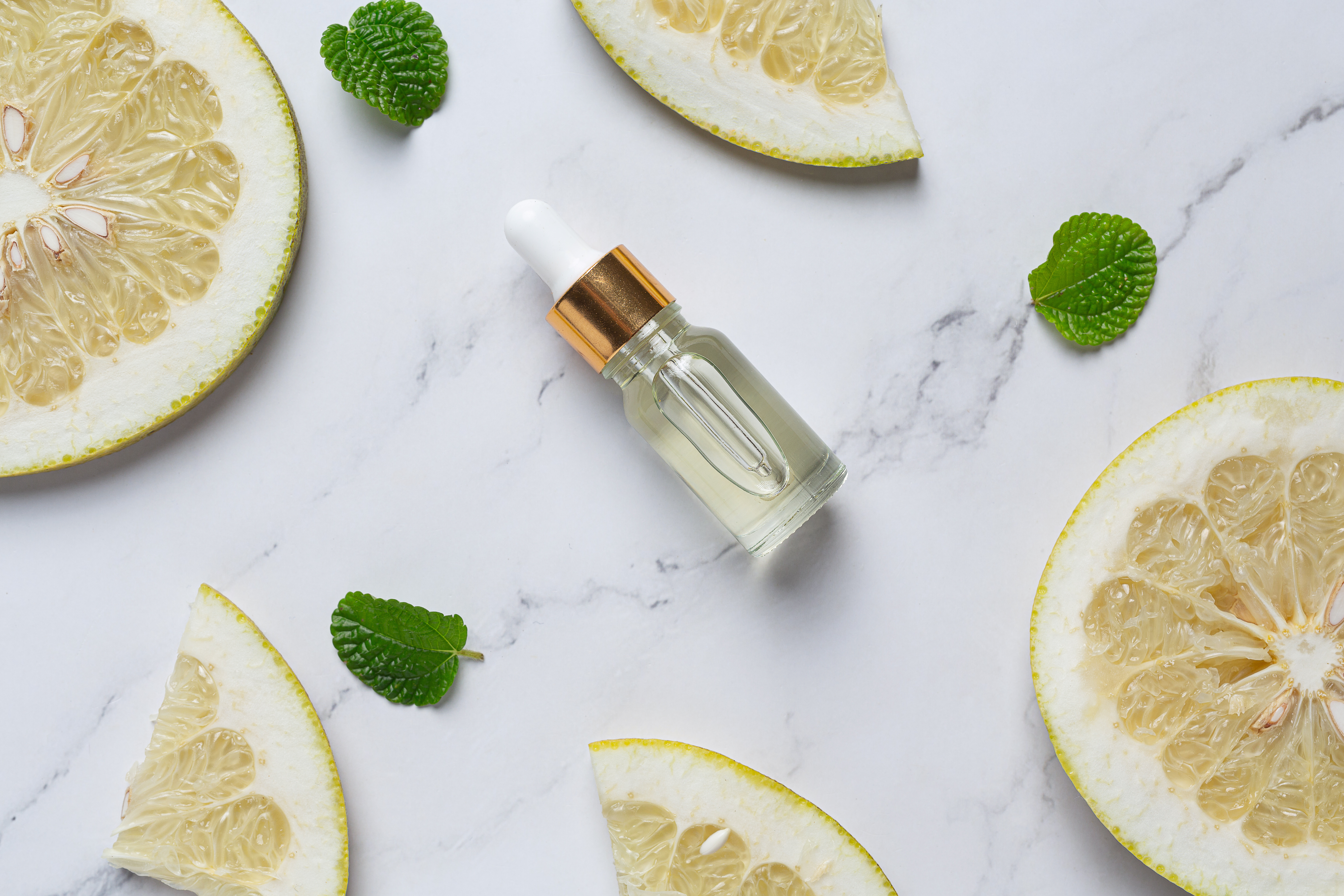3-O-ethyl-L-ascorbic acid has become a household name in the skincare industry for a few years now. The INCI name is Ethyl Ascorbic Acid. It can provide you with all the benefits of vitamin C wrapped up in the form of a gentler and more stable molecule. Hence, ethyl ascorbic acid represents a smart vitamin C derivative that you should try to include in your skincare routine.
Vitamin C is an essential skincare active. It is a true multitasker ingredient that can provide you with younger-looking skin, free of fine lines and wrinkles. Also, it is a potent antioxidant and a skin whitening molecule that can help you get rid of dark spots and even your skin tone.
The benefits seem to exceed expectations. However, vitamin C's most known derivative, L-ascorbic acid, is highly unstable, making it a complicated ingredient from the formulation point of view.
Furthermore, vitamin C needs the right vehicle to be absorbed deep into the skin layers. Otherwise, its benefits might be squandered. Hence, finding the right formulation (serums Vs. Vitamin C eye cream, for example) and the right derivative can be an impossible task for some.
Even though there are many options available, L-ascorbic acid is the obvious candidate. However, 3-O-ethyl-L-ascorbic acid is the ingredient to look for in your skincare formulations if you want less irritation without compromising performance.
The Importance of External Supplementation of Vitamin C
Most plants and animals synthesize vitamin C from glucose.
Humans are unable to synthesize ascorbic acid due to the absence of the enzyme L-glucono-gamma lactone oxidase. Hence, external supplementation is necessary.
However, oral supplementation, even on high doses, translates into a small fraction of biologically active vitamin C. Consequently, we depend on topical application of creams, serums, and other cosmeceutical formulations to take complete advantage of vitamin C skin benefits.
What is L-Ascorbic Acid?
Vitamin C is an umbrella term to name many vitamin C derivatives available in the market. The most common, potent, and well-studied is L-ascorbic acid (pure vitamin C).
Specifically, L-ascorbic acid is the bioactive form of vitamin C, which is the way our body and skin can process and get benefits from.
The problem with L-ascorbic acid, though, is that it is highly unstable and oxidizes (inactivates) pretty quickly, shortening the product's shelf life and efficacy. This process is usually accompanied by a color change in the formulations, turning gradually yellowish or completely brown.
In general, cosmetic formulations with a higher viscosity and multiple emulsified systems offer protection against premature oxidation. Studies show that humectants present in vitamin C eye creams, for example, can influence the photostability of the molecule positively.
Additionally, the development of micro and nano encapsulated delivery systems are strategies intensively researched in the last years, although there is a long way to go. Many studies have also been oriented to developing more stable molecules that retain an excellent performance.
3-O-Ethyl-Ascorbic Acid: A More Stable Vitamin C Derivative
Ethyl ascorbic acid was developed in the process of finding more stable molecules, paving the way for gentler yet effective vitamin C derivatives.
3-O-ethyl-L-ascorbic acid is a molecule made of L-ascorbic acid chemical structure with an additional ethyl group in the third carbon position. The ethyl group makes the molecule highly stable and soluble in both oil and water.
Ethyl ascorbic acid is more lipophilic than the original, exhibiting improved permeation into the deep layers of the skin and demonstrating an efficient transdermal activity.
Once absorbed by the skin, the molecule loses its modification and turns into pure L-ascorbic acid, which is then metabolized to give you all its benefits.
Additionally, 3-O-ethyl-L-ascorbic acid has a slow-release, ensuring that you are not exposed to toxic effects or potential skin irritation.
3-O-Ethyl-Ascorbic Acid Benefits
3-O-ethyl-L-ascorbic acid is a potent antioxidant in our skin. It neutralizes the oxidative stress caused by solar radiation (UVB), pollution, and smoking. Also, it protects the skin from solar damage or photoaging by neutralizing inflammatory cytokines, such as IL-6, though it will never replace your sun blocker.
This vitamin C derivative helps to neutralize free radical's damage by facilitating electron transfer or donation. Free radicals could translate into damage of the DNA in our cells, the cell membrane, and cellular proteins, eventually causing melanoma.
Equally important, 3-O-ethyl-L-ascorbic acid-enriched topical products also have an important antiaging effect. This skincare active boosts collagen biosynthesis and decreases its degradation, translating into a younger-looking skin with increased firmness and elasticity.
Additionally, vitamin C is also known as an important replenisher of vitamin E, which is another antioxidant with photoprotective properties. Several clinical studies have demonstrated the synergistic antioxidant effect of vitamins C and E, explaining this powerful duo cosmetic presentations.
Lastly, vitamin C gets rid of dark spots caused by sun damage, aging, acne scars, or pollution. It is a powerful anti-pigmentation agent that inhibits the action of the enzyme tyrosinase—the main enzyme responsible for the production of melanin—thereby decreasing melanin levels and hyperpigmentation.
How to use 3-O-Ethyl-Ascorbic Acid
Cosmetic formulations containing ethyl ascorbic acid can be used twice a day to clean skin, especially in the daytime, to take advantage of its photo-protection properties to the fullest.
Moreover, 3-O-ethyl-L- ascorbic acid is highly compatible with other active ingredients. It is recommended to use mild exfoliating acids and other antioxidants, such as niacinamide and retinol, to complement their activity. Also, it makes a powerful duo with moisturizers like squalene!
Ethyl ascorbic acid is gentle enough and has not shown harmful effects on the skin. There have been reports of rare mild allergic reactions from people with sensitive skin types, so you should do a patch test on the skin before applying it to your entire face.
A Final Word
The 3-O-ethyl-L-ascorbic acid is a powerful antioxidant that can give you a brighter skin complexion and help you get rid of fine lines and wrinkles.
Indeed, ethyl ascorbic acid is a newer form of vitamin C that offers better overall performance. Compared to the traditional, more used L-ascorbic acid, it is water-soluble, highly stable, and easy to formulate.
Once absorbed, 3-O-ethyl-L-ascorbic acid needs to be converted to its bioactive form. Then, in the form of L-ascorbic acid, it is metabolized and can provide you with multiple benefits.
In general, studies have shown that most vitamin C products that don't use L-ascorbic acid could be less potent. But you could sacrifice some potency for more stability because this could translate to more efficacy in the long run.
Hence, you should definitely try to incorporate 3-O-ethyl-L-ascorbic acid into your skincare routine. It definitely stands out as an excellent vitamin C derivative that combines efficacy with great stability, and more importantly, with less irritation.
References
- Iliopoulos, F., Sil, B., Moore, D., Lucas, R., & Lane, M. (2019). 3-O-ethyl-l-ascorbic acid: Characterisation and investigation of single solvent systems for delivery to the skin. International Journal Of Pharmaceutics: X, 1, 100025. doi: 10.1016/j.ijpx.2019.100025
- Chen, S., Hseu, Y., Gowrisankar, Y., Chung, Y., Zhang, Y., Way, T., & Yang, H. (2021). The anti-melanogenic effects of 3-O-ethyl ascorbic acid via Nrf2-mediated α-MSH inhibition in UVA-irradiated keratinocytes and autophagy induction in melanocytes. Free Radical Biology And Medicine, 173, 151-169. doi: 10.1016/j.freeradbiomed.2021.07.030




